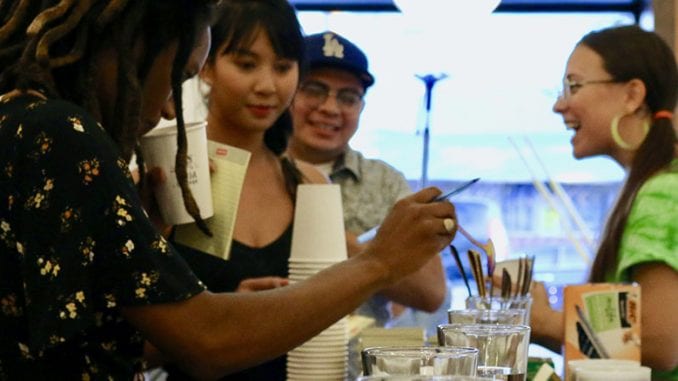
Advocating for more diverse voices in the coffee industry, the educator and author of The @wastingcoffee Guide to Not Wasting Coffee led a workshop that explored the different frameworks baristas have for tasting.
BY VALORIE CLARK
SPECIAL TO BARISTA MAGAZINE ONLINE
Photos by Valorie Clark
On October 26, Umeko Motoyoshi traveled to Los Angeles to lead a coffee tasting workshop at Kindness and Mischief Coffee, a cafe in Highland Park. Over 30 people piled into K&M, with the excited crowd eager to hear Umeko speak. The focus of the workshop was on tasting, but not on how to taste. Instead, Umeko discussed the ways that baristas, especially non-white baristas, have been marginalized at the cupping table.
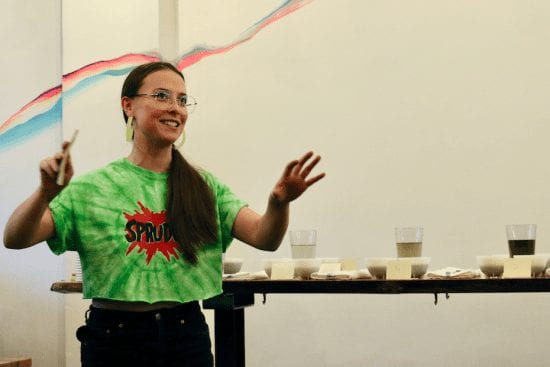
Umeko grew up going to Asian markets with their father, who was a Japanese tea ceremony master, so discerning taste was something they’d always been aware of and began practicing early.
But when they joined the coffee industry, they were told that they couldn’t taste. “White people told me I didn’t know how to taste,” Umeko said. They explained that flavor notes are often assigned by just one or two people in a company. Generally people assign notes by breaking down what they’re tasting and trying to translate it into something else—candy, fruit, etc. They spent years trying to conform to the traditional spread of tasting notes the American coffee industry relies on to describe coffee.
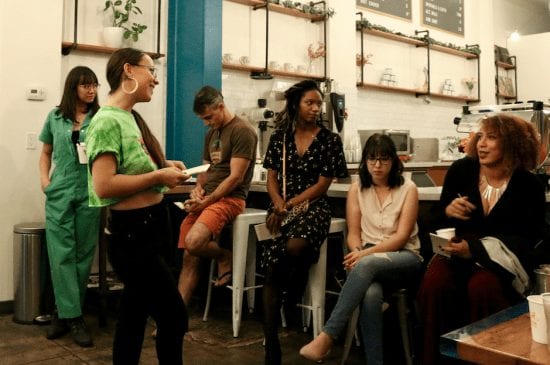
Umeko shared a story of when they mentioned that they tasted lychee, a fruit that’s native to certain regions in China, in a cupping room. Someone who had perhaps never tasted lychee told them that was wrong. And that’s how the “Subjective Objectivity: Tasting Your Truth” class was born. Eventually, Umeko realized the flaw in the setup, and how deeply it runs.
The flavor wheels and the most often used tasting notes were designed and selected by people who came from a certain culture, eating certain foods. The sensitivity of each person’s palate is limited by what they’re used to eating. So different cultures mean different foods—which mean different palates. Those frameworks for flavor references didn’t align with the framework Umeko had developed eating Asian food in their childhood.
Despite the slightly fustian title of it, the class they taught was an accessible hands-on approach to exploring flavors and your own palate.
Years of experience in the coffee industry have imbued Umeko’s perspective with pearls of wisdom. They broke down some of the problems at the cupping table, which include many easily solvable issues, like not placing a traditionally delicate coffee to be tasted after a fuller-bodied coffee.
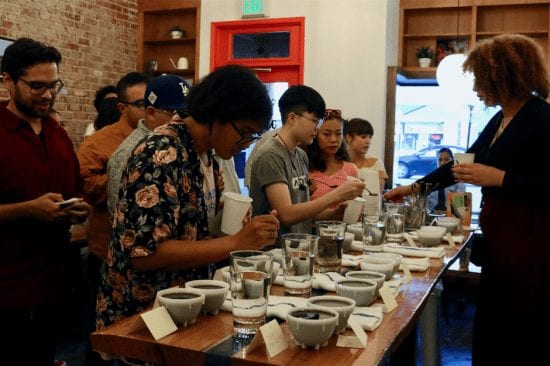
Another important point they made was that the human tongue can really only handle tasting about seven to nine different things—after that we begin to suffer from palate fatigue. Having too many coffees at the table is basically an exercise in self-sabotage on a large scale. An easy fix for that can be to rinse with water in between each cup, and to take more breaks. They pointed out that a rinse is something done in every other food industry—why not coffee?
After the talk, Umeko began the sensory exercise, which they developed specifically for teaching people about palate differences and development. It involved three rounds of tasting, with discussion in between each round.
During the first round, everyone tasted and wrote down what they thought they were tasting from six cups filled with mystery ingredients. Umeko had asked Mo Maravilla, the owner of Kindness and Mischief, to put black food coloring in each cup to eliminate color bias. Cups had been organized so that none overpowered the next ingredient in the line.
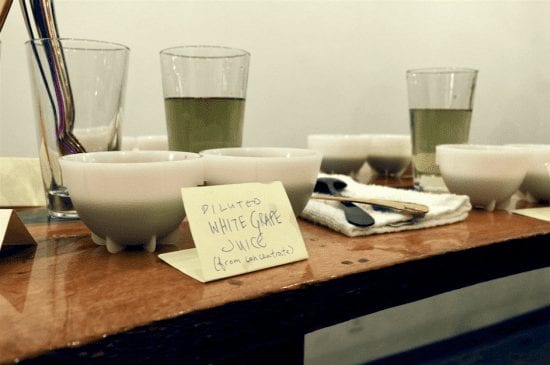
Umeko then led a conversation for all of the guests to talk about what they had tasted in each cup during the first round. The focus was less on guessing what the flavor was and more on what they were experiencing—where they tasted it on their tongue, and what it reminded them of. Umeko discussed the concept of the “alpha” taster several times—the person in the cupping room who dominates the conversation, whose palate is considered “right.” Umeko specifically wanted to avoid establishing an alpha taster that night. Instead everyone’s input was accepted, and guests were asked not to reveal if they had guessed the ingredient correctly. Later in the discussion, Umeko revealed that the ingredients were six different fresh fruit juices.
The next round of tasting contained three cups, and each held a combination of two of the juices from the first round. Things got interesting—even knowing that there were only six possible flavors in each cup, everybody struggled with the exercise. During the debrief, few people guessed both ingredients correctly.
The third round of tasting ended up drawing audible groans from some participants by its end. Only two cups were present. Each contained mixes of three juices from the first round. Once again, even while knowing what the possible ingredients were, people couldn’t tell what was in the cup.
This wasn’t a group of beginning baristas or laypeople, either. Of the 30+ people present, most were coffee professionals. Many had been in the industry for several years. Some hold big, visible positions and are considered extremely skilled in tasting.
And yet, many of them couldn’t guess what three flavors were present in each cup in the third round. Even Umeko, who had done the mixing, wasn’t sure of their guesses.
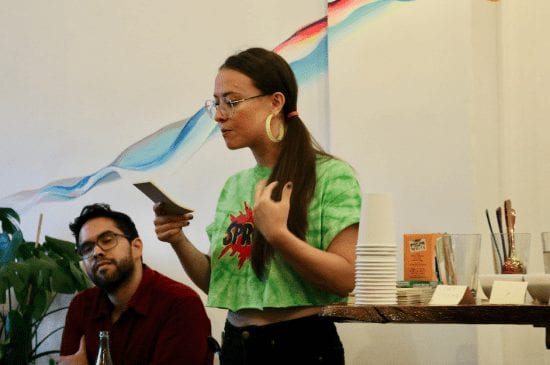
So what did we learn from this event and its exercises?
One of the big takeaways was that combinations of ingredients can create phantom flavors—tastes that seem present in the cup even though they’re emphatically not, at least in this case. This can help explain the wide variety of what people taste in any one coffee.
As Umeko pointed out, “Even when there’s real fruit juice in the cup, we can’t tell what it is … so how are we going to do it in coffee when there isn’t even fruit in the cup?” We’re all fumbling blindly toward any sense of agreement about flavor notes. And therefore, there really can’t be a right or a wrong about what someone tastes. In closing, Umeko cheerfully told the crowd, “Next time you taste lychee and some white guy tells you you’re wrong, you can say, ‘No, you’re f*cking wrong!’”

ABOUT THE AUTHOR
Valorie Clark (@TheValorieClark) is a freelance writer with a background in specialty coffee. She is based in Los Angeles.

